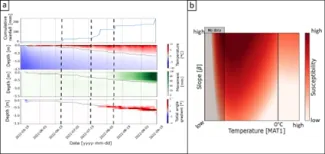Combined temperature and deformation measurements across adjacent hillslopes provides new insights on hillslope movements caused by seasonal thawing in arctic regions.
Understanding the controls on soil movements along hillslopes is crucial to improve assessment and prediction of carbon fluxes and infrastructure hazards in a warming Arctic, but there are challenges associated with measuring depth-resolved profiles of soil deformation and temperature at numerous locations. We established an extensive and novel soil deformation and temperature sensor network covering 48 locations within the 1 km² Teller study site watershed on the Seward Peninsula, AK, spanning adjacent hillslopes in a warm permafrost environment. Depth-resolved measurements down to 1.80 m depth were taken between May and September 2022, a period conducive to soil movement due to deepening thaw layers and frequent rain events. We found that movements predominantly occurred near the thawing front, commencing as thawing reached depths from 0.40 to 0.75 meters. The largest movements were observed at the top of the south-east facing slope, where soil temperatures were cold and slopes were steep. Three primary factors influenced movements: slope angle, soil thermal conditions, and thaw depth. This underscores the significance of a precise understanding of subsurface thermal conditions, including spatial and temporal variability in soil temperature and thaw depth, when assessing susceptibility of slope instabilities.
Citation: Fiolleau S, Uhlemann S, Shirley I, Wang C, Wielandt S, Rowland J, Dafflon B. 2024. Insights on seasonal solifluction processes in warm permafrost Arctic landscape using a dense monitoring approach across adjacent hillslopes. Environmental Research Letters 19: 044021. https://doi.org/10.1088/1748-9326/ad28dc
Associated Dataset: Fiolleau et al. 2023. Continuous soil temperature and soil deformation measurements, Teller Road Mile 47, Nome, Alaska. Next-Generation Ecosystem Experiments (NGEE) Arctic, ESS-DIVE repository. https://data.ess-dive.lbl.gov/datasets/doi:10.15485/2251663 on 2024-06-20
Contacts & email addresses: Sylvain Fiolleau (sfiolleau@lbl.gov); Baptiste Dafflon (bdafflon@lbl.gov)


